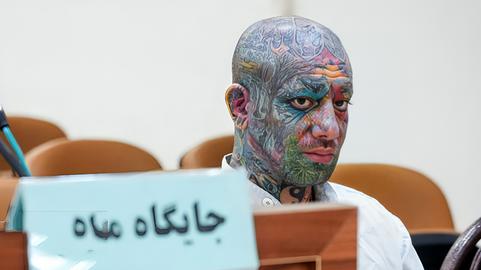Salvador, the capital of Bahia in the northeast of Brazil, is known for its wish ribbons. Worn by people around the country and the world for good luck, they adorn the gates of the Church of Nosso Senhor do Bonfim and were originally introduced to Brazil in the eighteenth century. Traditionally, the ribbons are given out by Baianas, women who follow the African Candomblé religion, known for selling acarajé, a savory treat made out of black-eyed beans, in the markets and streets of Salvador, dressed in traditional clothing. Traditionally, when they present the ribbons, or fitinhas, as they are known in Portuguese, they grant three wishes.
The original ribbons were said to be the exact length of the arm of Senhor do Bonfim, the patron saint of Bahia. But the significance of fitinhas now goes well beyond folklore or fashion. For many, they retain their sacred or spiritual significance, but today they enjoy a social and political currency as well. Politicians, activists and celebrities wear them, showing solidarity with political movements or a good cause.
When Aécio Neves, presidential candidate for the Party of Social Democracy, was given the title of Citizen of Salvador as part of his induction into the Board of Alderman of Bahia, he was presented with a blue ribbon—blue being the color used by the local coalition party that rivals President Dilma Roussef and the Workers Party. Women dressed as Baianas de Acarajé presented the ribbon to Neves. And the president herself has recently been seen wearing a fitinha complete with gold and diamonds. A similar one is worn by the mayor of Salvador, ACM Neto, in support of opposition candidate Neves.
Salvador, which will host a number of games during the World Cup, including the Iran vs Bosnia-Herzegovina on June 25, anticipates the sale of a record number of fitinhas. FIFA has created its own version, which cost RS$4.99 each.
What causes, ideas or messages will be communicated using this once-sacred piece of thread?
In an increasingly connected world, it’s easy to make links between Brazil’s history of fitinhas and messages of solidarity in other places in the world. And wearing a ribbon is a simple way of making a statement, whether its AIDS/HIV awareness, fighting breast cancer or sending a clear message of one’s political affiliations. Though fitinhas have a specific resonance for Brazilians, these simple pieces of cloth can have enormous power to bring people together and share ideas, hopes and messages.
One of the strongest examples of this in recent years is Iran’s Green Movement. And perhaps, when they encounter fitinhas, some football fans attending the Iran-Bosnia match will be reminded of the green ribbons worn around the world in 2009, a global show of solidarity in the wake of that year’s disputed presidential elections.
Every year, in January, authentic Baianas de Acarajé wash the stairs of the church of Senhor do Bonfim. It´s both a religious and profane party. The population renew their vows to Senhor do Bonfim, and drink and dance in the streets of the ancient Lower City of Salvador, where the church is located. Politicians from all over Brazil come to the party to show their faces and—why not?—make three wishes.
The ribbons originally made their way to Brazil via Silva Serva (1760-1819), a typographer who moved from Portugal to the then-capital Salvador and who was eventually made treasurer of the church. By producing handmade ribbons directly associated with the patron saint, he was able to imbue humble fabric with spiritual significance, making them extremely valuable. He discovered he could not only give the church’s congregation an opportunity to display their piety and religious commitment, he was also able to bring in a considerable amount of money for the church, charging a small fortune for these handmade, sacred items. Silva Serva’s great grandson, journalist Leão Serva, has just published a book about Silva Serva. A Typographer in the Colony (Um Tipógrafo na Colônia) was published on May 12 by Publifolha publishing house, and looks at the history of fitinhas and his great grandfather’s legacy. He was, Leão Serva says, one of the world’s early marketing gurus.
Reflecting on the valuable replicas of fitinhas the president and other politicians wear, Serna says it is more in line with the original, very valuable ones worn by church-goers in the nineteenth century. It’s a far cry from the cheap ribbons made out of polyester sold on the streets of Salvador today.
For Leão Serva, it’s strange that the fitinhas have lived on but the books and other publications his relative produced have almost all been lost.
“The irony, of course, is the fact that he had a great importance for literary culture in Brazil, but he´s only reminded as a folklore propellant.” Fitinhas were also given out as as a souvenir during the launch of his book.
The image of Senhor do Bonfim was introduced to Salvador y Theodósio Rodrigues de Farias, a Portuguese navigator from the city of Setúbal, in 1745. Rodrigues de Farias became a slave trafficker, and spent a great deal of gold to built the church of Senhor do Bonfim at the top of a hill. It’s become a center of devotion for Catholics and is known as the sacred hill. Later, the Candomblé religion embraced the Bahian Jesus Christ, known as also Oxalá, the spirit or orisha that created the world. Slaves were among those who prepared the chapel for the celebration of the Senhor do Bonfim saint. For the people of Bahia, whether they’re followers of Catholicism or the Candomblé religion, or those who pay homage to the region’s rich history in a secular manner, Senhor do Bonfim plays an important role, unifying the community.
Fitinhas, says Leão Serva, “grew strong as a superstition and folklore; after some time, it became a symbol of tourism and then a symbol of reconciliation.” He’s a great believer in the ribbons’ power to convey range of feelings, ideas and beliefs.
“Senhor do Bonfim´s ribbons became a pop culture object, associated with the desire that dreams can come true. Everybody that has a dream and wants it to be realized is target for this marketing”, says Leão Serva.
And it’s here that the Brazilian fitinhas, a powerful mix of popular culture and religious history, might, during the World Cup at least, prove to be a strong symbol of resistance for Iranian democracy activists and their supporters. Most football fans won’t want to think about politics during the World Cup. But the popular ribbons are a reminder that, interwoven into what’s enjoyable about everyday life—sport, music, culture—are other messages, about freedom and wishes that can come true.
























comments